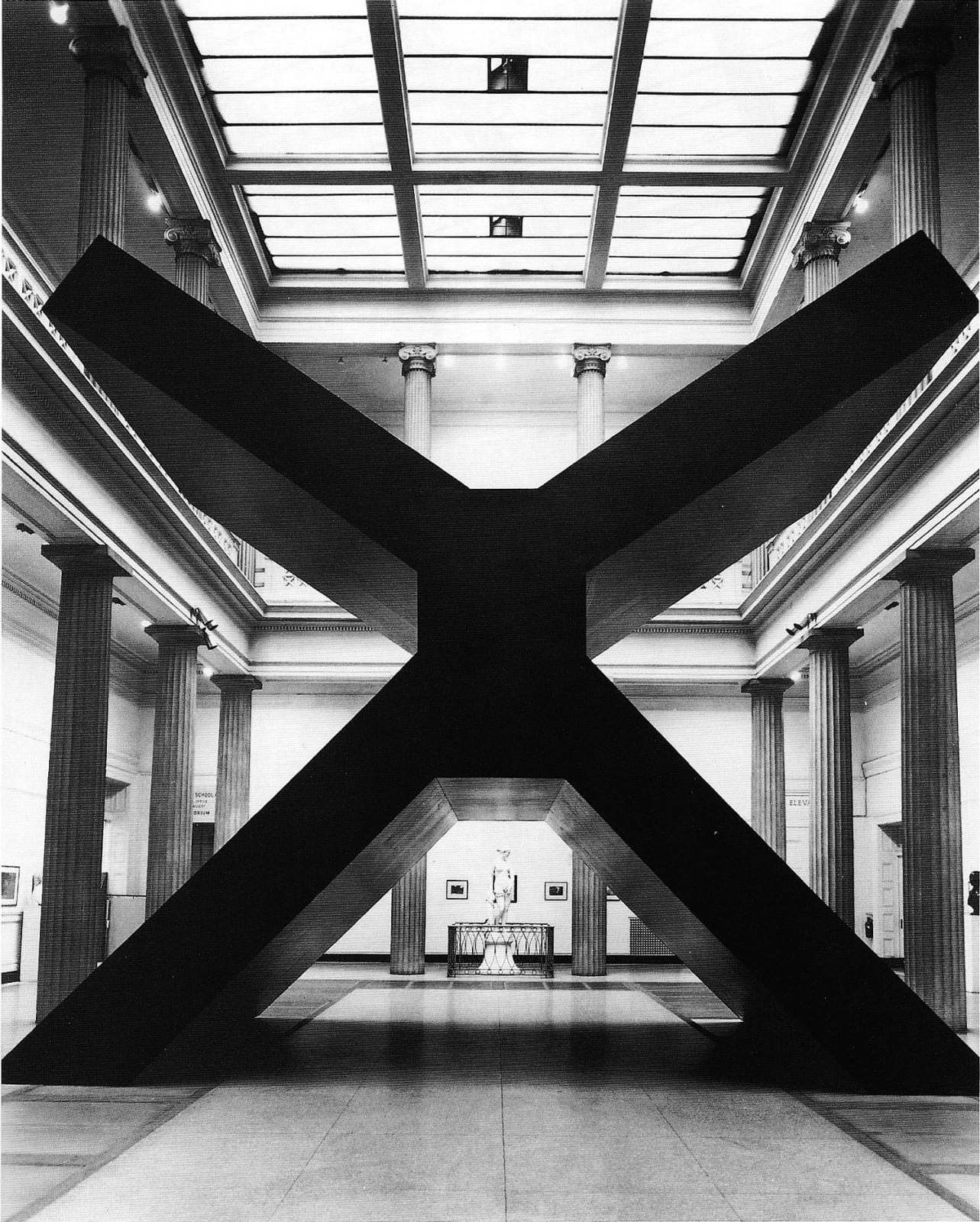Ronald Bladen American, (1918-1988)
670.6 x 731.5 x 426.7 cm.
Provenance
Estate of Ronald Bladen
Exhibitions
Washington, DC, Corcoran Gallery, Scale as Content, 1967 (Wood monumental version)
Literature
Bladen, Ronald, Barnett Newman, and Tony Smith. Scale As Content: Ronald Bladen, Barnett Newman, Tony Smith : [Exhibition] The Corcoran Gallery of Art, October 7, 1967 to January 7, 1968. [Washington, D.C.]: The Gallery, 1967.
Colpitt, Frances, Minimal Art: The Critical Perspective, UMI Research Press, 1990, illustrated on front cover.
Jacobi,Fritz, Ronald Bladen Skulptur/Sculpture: Works from the Marzona Collection, Nationalgalerie Staatliche Museen zu Berlin, 1998
Sandler, Irving, Ronald Bladen:Sculpture of the 1960s & 1970s, Jacobson Howard Gallery, New York,2008
Ronald Bladen first built the X in 1968 as a wood prototype.
The inner armature was made of lumber usually 2"x4" & 1"x2" screwed and bolted together. Sheets of plywood would be attached to the armature and all seams and holes would be filled and smoothed. Finally black low luster paint would be applied with brushes and rollers to create as close as possible the look and feel of metal.
These prototypes were the visual sample that showed what the actual fully realized sculpture in steel, at the time, and Aluminum later on would look like. Practically all prototypes were lost or its materials reused in other sculptures for matters of finance and storage.
#1/3 of Monumental version of this work is in the collections of Miami-Dade Art in Public Spaces as a gift of Partrick J Lannan Foundation currently on long term loan to the Miami Dade College, Wolfson Campus.
Mattison, Robert S. Ronald Bladen Sculpture: To Conquer Space. The Artist Book Foundation, 2018. pg. 42, 44.
The sculpture filled the classical courtyard of the Corcoran, extending to the edges of the Doric columns that supported its balcony and rising to the second story. X embodies the sheer visual power of a single, absolutely coherent image. It is one that burns itself into the viewer’s mind and cannot be easily forgotten once seen. Riff relies on constantly changing views. By contrast, X exemplifies complete visual resolution; it commands and totally controls the architectural space surrounding it. Sculptor Ursula von Rydingsvard, who studied with Bladen at Columbia University, said, “X fills the space and pushes out on both sides with strength, satisfaction, and seduction.”
Widely circulated images of X within the Corcoran’s atrium, including the one on the cover of Artforum International, have become symbols of the dynamic force of modern art of the 1960s, replacing an Old World aesthetic.
Because of its scale, X entailed the most complicated construction processes of Bladen’s career thus far. Also, photographs taken at the museum during its construction provide the best documentation of the interior design of one of his wooden prototypes. Irving Sandler called the interior scaffolding of his work as “famously overbuilt.”
Thus, the X had references to the natural world for Bladen, but, as indicated by the story above, it signals a human presence in nature. In fact, the X is an ancient symbol that extends to human prehistory. It is found in the Paleolithic cave markings of Altamira and on Bronze Age Mycenaean vases. It is the Roman numeral for ten, and it appears in medieval manuscripts and as a heraldic sign on medieval warriors’ shields. The X also references intersecting forces. It combines a balanced core with powerfully extended arms. It is clearly also a symbol for the human being with extended limbs. Leonardo’s famous Vitruvian Man (c. 1490, Academia, Venice), with his arms and legs extended to form an X, is inscribed within both a circle and a square; for Leonardo it was an expression of human perfection. A recent sociological study has shown that raised arms as a sign of triumph is even made by blind athletes who would not have been able to visually learn this gesture.
In mathematics, the X is a designated replacement for an unknown factor. Of course, the X is also an essential engineering device used to stabilize structures by resolving tensile and compressive forces. Bladen’s X calls to mind all of these associations, but it is neither nature nor human being, and it is not architecture. The artist created a new thing in the world that moves us by its own existence. He said in an unpublished interview, “I worry about the totality of a piece and its physical presence, the clarity of presence and the dignity.”
Join the gallery mailing list
* denotes required fields
We will process the personal data you have supplied to communicate with you in accordance with our Privacy Policy. You can unsubscribe or change your preferences at any time by clicking the link in our emails.
